A search for the origins of the brain Inspire article
Detlev Arendt, a molecular biologist at the European Molecular Biology Laboratory, Heidelberg, Germany, describes to Russ Hodge how his cutting-edge research is following in the footsteps of a 19th-century scientist.
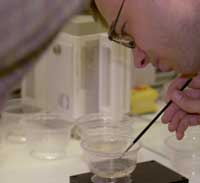
Through the glass windows of his tiny office, you can see four or five members of Detlev Arendt’s research team pipetting, scribbling in their lab notebooks, and preparing experiments. Detlev ventures out into the lab every day, but he feels most at home at his desk, surrounded by stacks of books and journal articles.
“By nature I’m more of an armchair scientist,” he says. “I could easily spend my whole day reading and writing. But the best science comes from a marriage of theory and lab work. You can have great ideas, but when you produce data, things often turn out differently than you imagined, and the end result is more beautiful.”
Even Charles Darwin, fresh off the ship HMS Beagle, had to put in his time at the microscope; he was told that a “serious biologist” had to have studied one organism exhaustively and contributed original work on it. As a result, he dedicated himself for a decade to a creature which, until then, had received little attention: the barnacle.
The armchair approach has been unusually successful for Detlev, starting during his third year of biology studies at university. He says he was a “typical undergraduate”, not terribly concerned about a career. He chose biology because in school he had been attracted to the most complicated topics he could find, and biology was certainly complicated enough.
Detlev had also considered working in ecology. He had been introduced to the field during an 18-month period of civil service that young German men can choose instead of military service, when he had given guided tours of the North German seashore. “It’s a fascinating habitat,” he says. “The tide runs out, and you can walk for kilometres and kilometres among the mud flats, finding millions of worms, mussels and snails that you don’t see anywhere else.” But when it came to deciding which subject to concentrate on at university, Detlev felt that ecology didn’t offer enough, and he chose biology instead.
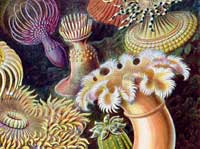
Haeckel’s Kunstformen der
Natur (1904), showing various
sea anemones classified as
Actiniae (detail)
When it came time to write his thesis, he went to the library to read. Two topics that interested him tremendously were evolution and development: how animals’ bodies grow from single egg cells. At the time, these two fields had started to come together on the molecular level, following in the footsteps of a 19th-century German scientist named Ernst Haeckel.
“Haeckel put forward the idea that as an individual animal body forms, it goes through phases that resemble the history of its evolution as a species. So human embryos start off as single cells, then go through stages that first resemble very simple multicellular animals, then worms, fish and mammals, before they finally take on a form that is uniquely human.”
A century later, scientists began to understand that tissues and body structures arise when young cells activate new sets of genes, changing their shapes and interactions, building tissues and organs. Molecular developmental biology and genetics were coming together in a new research field called evolution and development – or ‘evo-devo’.
In the early 1990s, as Detlev sat in the library, this new field was in its infancy. One amazing study revealed that a particular family of genes had been conserved through nearly a billion years of evolution in all sorts of organisms. Called the homeobox (HOX) genes, they lay down the basic head-to-tail organisation of the body plans of widely diverse animals. HOX genes are arranged next to each other on a chromosome, like a string of words making up a sentence. As cells in the early embryos of animals divide, HOX genes are activated one after another, in the order in which they appear on the chromosome. The result is the step-by-step formation of the head and lower segments of the bodies of worms, flies and humans.
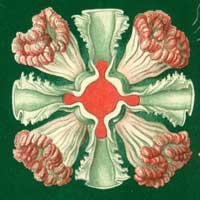
Haeckel’s Kunstformen der
Natur (1904), depicting
organisms classified as
Discomedusae (detail)
Were other body parts built using ancient blueprints like the HOX genes? “People went looking for patterns,” Detlev says. “For example, they had discovered molecules that formed the ventral and dorsal – upper and lower – sides of flies. Then they began looking for relatives of these genes in mammals. They found most of the crucial ones, and there was literature about how mutations in these genes affected the body plans of mammals. But at first there didn’t seem to be a strong parallel between insects and vertebrates.”
Detlev read paper after paper in search of similarities between mice and flies. As he stared at two papers lying side-by-side on his desk, one about insects and the other about mice, a pattern suddenly leapt out at him.
“Maybe there was a simple genetic programme to determine these sides after all,” he says. “All you had to do was make one assumption – that the genes that formed the ventral side of insects were forming our dorsal side, and vice versa. In other words, at some point in evolution, vertebrates had flipped over.”
Detlev raced through all the literature he could find on genes that guided these developmental processes. Everything he found suggested that he was right. So he checked the results with one of his teachers at the University of Freiburg, Katharina Nübler-Jung. She encouraged him to send a letter to one of the most important scientific journals in the world – Nature.
The result was something almost unheard of – Nature printed a scientific communication from an undergraduate student. Scientists everywhere peered more deeply into Detlev’s hypothesis, even seeing patterns in their own data that they had missed. He began to receive invitations to conferences all over the globe. Not only was it exciting to be invited to so many places – it also gave him a thesis topic.
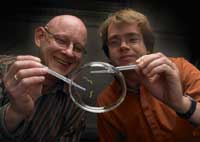
Detlev Arendt
Detlev walks me from his office, through the lab, then down the hallway to another room. Here are aquaria full of his favorite organism: a small marine worm called Platynereis dumerilii. Detlev brought the animal to EMBL when he began doing postdoctoral work in the lab of Jochen Wittbrodt.
Detlev was working on a fascinating question: he wanted to discover the very early evolutionary origins of the brain. This was an excellent match with Jochen’s work, he says, because Jochen was interested in studying the origins of the eye. And if you go back far enough in evolution, it’s really the same question.
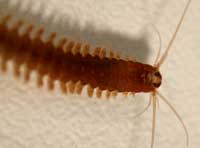
To explain this, he takes down a round dish containing some worms swimming energetically. This simple creature holds important clues to the origins of our own brain. “All living animals with brains and eyes – from insects to humans – descend from one ancestor; Platynereis descends from it as well,” he says. “That ancestor had a symmetrical body plan from head to tail: the right and left half mirrored each other. Before it evolved, there were other forms of life that didn’t have this symmetry, like sponges.”
Some features of this worm resemble that ancestor more than today’s insects and vertebrates, making it something like a “living fossil”. The Platynereis brain is like a blueprint for what insect and vertebrate brains have in common, and thus for the brain of their common ancestor. By studying its development, Detlev hopes to discover how the first brains arose.
Where does the brain come from? The question can mean two different things, Detlev says. The first is how our species’ brain evolved. The second is how an individual’s brain grows from a single cell. Very recently, following in the footsteps of Ernst Haeckel, scientists like Detlev have begun to connect these two stories.
A fertilised egg divides over and over, differentiating into specialised types of cells like blood, muscle and neurons, which form all of our tissues and organs within the space of nine months. This happens because our genetic code contains instructions for producing tens of thousands of different molecules, like a huge recipe book. Although every cell in our bodies contains a copy of the entire book, each type draws on only a subset of the recipes, producing a unique cocktail of molecules that determines its shape and behaviour. Modern technology allows scientists to analyse that protein cocktail, yielding a “molecular fingerprint” that identifies the type of cell. This permits them to discover cells that are just on the verge of becoming the first nerves and parts of the brain, long before there are any recognizable organs.
Detlev is convinced that the molecular fingerprint can also be used to find related cells among different species. Over nearly a billion years, he believes, evolution has held onto the basic recipe for creating the major cell types and organs. Similar cell types in different animals will share the most important ingredients of the cocktail because they were inherited from a common ancestor. So if you can find those cells in insects, fish and mammals, and then pin down a common recipe, you most likely have the original cocktail for building brains. The patterns can be tested by checking them against what happens in Platynereis.
It’s a new method that changes the way biologists are learning about evolution, and Detlev thinks it has solved a great debate about one of Darwin’s evolutionary riddles: how many times nature “invented” the eye. Even after the closest scrutiny of cells from different species under the electron microscope, scientists came to many different conclusions – estimates ranged from two to 40 different acts of “evolutionary invention” for eyes.
The fingerprinting method has permitted Detlev, Jochen and many enthusiastic PhD students to clear up some of the confusion. “I’d be lost without my students,” Detlev laughs. Starting with the key genes involved in making light-sensitive cells in insects, they checked for related molecules in the genomes of mammals and fish. Then they began scanning early larvae of Platynereis, probing for cells that used these genes. A pattern emerged: in all of these different species, the same recipe was being used to make two fundamentally distinct types of photoreceptor cells. So even though the eyes of today’s insects and vertebrates look very different– even down to the architecture of the cells that compose them – they can be traced back to these two types of light-sensitive cells.
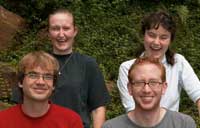
Heidi Snyman, Kristin
Tessmar, Patrick Steinmetz
and Detlev (clockwise from
top left)
The project has also given the scientists a detailed view of how evolution can generate different organs from the same basic cell types. Photoreceptor cells are used to create many different structures; different branches of life seemed to have spun off the cell in different ways. But they are all somehow related to the eye and its connections to the brain.
The work with Jochen has now given Detlev – “and my enthusiastic students” – the tools they need to tackle the question of brain evolution. Doing so will require a healthy mix of ideas and data. That’s nothing new in the science of evolution. Evidence that species could change had been known for a long time; it took a young man about Detlev’s age to step back from the data, retreat to his armchair, and weave it all together into a coherent theory. So it shouldn’t come as a surprise that taking care of Charles Darwin’s unfinished business, from 150 years ago, will require a similar approach.





